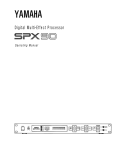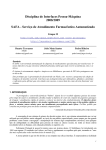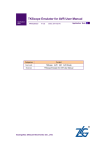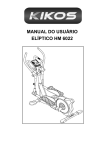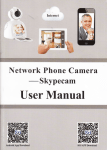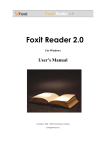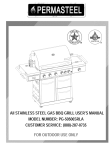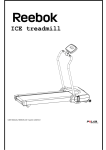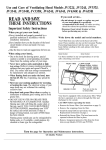Download Korg Guitar A5 User's Manual
Transcript
Thanks to Atila Sendil for the source of this manual. (www.atila.servebeer.com) CONNECTION WITH GUITAR 3 PLAYING PRESET PROGRAMS [PROGRAM MODE] 4 OPERATING INDIVIDUAL EFFECTS [MANUAL/EDIT MODE] 5 CREATING ORIGINAL PROGRAMS [Manual/Edit Mode] 6 SAVING EFFECTS [PROGRAM WRITE] 8 OTHER USEFUL FUNCTIONS 9 IMPORTANT SAFETY INSTRUCTIONS WARNING : When using electric products, basic precautions should always be followed, including the following: Read all the Instructions before using the product. To reduce the risk of injury, close supervision is necessary when a product is used near children or the like. This product, either alone or in combination with an amplifier and headphones or speakers, may be capable of producing sound levels that could cause permanent hearing loss. Do not operate for a long period of time at high volume level or at a level that is uncomfortable. If you experience any hearing loss or ringing in the ears, you should consult an audiologlst. The product should be located so that its location or position does not interfere with its proper ventilation. The product should be located away from heat sources such as radiators, heat registers, or other products that produce heat. The product should be connected to a power supply only of the type described in the operating Instructions or as marked on the product. The power-supply cord of the product should be unplugged from the outlet when left unused for a long period of time. Care should be taken so that objects do not fall and liquids are not spilled into the enclosure through openings. The product should be serviced by qualified service personnel When: The power supply cord or the plug has been damaged, or Objects have fallen, or liquid has been spilled into the product; or The product has been exposed to rain or The product does not appear to, operate normally or exhibits a marked change In performance, or The product has been dropped, or the enclosure damaged. Do not attempt to service the product beyond that described in the user- maintenance instructions. All otherservicing should be referred to qualified service personnel. See www.hgroenewegen.tmfweb.nl for more 20 sept. 2003 Congratulations and thank you for purchasing the KORG A5 GUITAR Performance Signal Processor. To get the most out of this advanced instrument and enjoy it in its optimum condition for the longest possible time, please read this manual carefully, and keep it handy. TABLE OF CONTENTS NAMES AND FUNCTIONS OF CONTROLS AND TERMINALS CONNECTION WITH GUITAR PLAYING PRESET PROGRAMS [PROGRAM MODE] OPERATING INDIVIDUAL EFFECTS [MANUAL/EDIT MODE] CREATING ORIGINAL PROGRAMS [Manual/Edit Mode] UTILITY SAVING EFFECTS [PROGRAM WRITE] OTHER USEFUL FUNCTIONS 1 Comparison with Preset Data 2. Using Volume Pedal EFFECT PARAMETER LIST 1 COMPRESSOR [COMPRESSOR] 2 DISTORTION/OVERDRIVE [DIST/OD] 3.3BAND EQ [3 BAND EQ] 4. CHORUS/FLANGER [CHORUS/FL] 5 REVERB/DELAY [REV/DELAY] 6. UTILITY REINITIALISE PRESETS / RESTORE FACTORY DEFAULTS ERROR MESSAGES TROUBLESHOOTING SPECIFICATIONS AND OPTIONS 2 3 4 5 6 7 8 9 9 9 10 10 10 11 11 12 12 12 13 13 14 -THE FCC REGULATION WARNINGThis equipment generates and uses radio frequency energy and if not installed and used properly, that is, in strict accordance with the manufacturers instructions, may cause interference to radio and television reception. It has been type tested and found to comply wrth the limits for a class B computing device In accordance with the specifications in Subpart J of Part 15 of FCC Rules, which are designed to provide reasonable protection against such interference in a residential installation. However these is no guarantee that interference will not occur in a particular installation. If this equipment does cause interference to radio or television reception which can be determined by turning the equipment off and on the ussr is encouraged to try to correct the interference by one or move of the following measures: • Reorient the receiving antenna • Relocate the equipment with respect to the receiver• Move the equipment into a different outlet so that equipment and receiver are on different branch circuits. If necessary the user should consult the dealer or an experienced radio/television technician for additional suggestions. The user may find the following booklet prepared by the Federal Communications Commision helpful "How to Identify and Resolve Radio - TV Interference Problems'. This booklet is available from the US Government Printing Office, Washington D C 20402, stock No 004 - 000 - 0003454 - 4. CANADA THIS APPARATUS COMPLIES WITH THE "CLASS B" LIMITS FOR RADIO NOISE EMISSIONS SET OUT IN RADIO INTERFERENCE REGULATIONS. CET APPAREIL EST CONFORME AUX NORMES "CLASS B", POUR BRUITS RADIOELECTRIQUES. SPECIFIER DANS LE REGLEMENT SUR LE BROUILLAGE RADIOELECTOIQUE. See www.hgroenewegen.tmfweb.nl for more 20 sept. 2003 Pg 1 NAMES AND FUNCTIONS OF CONTROLS AND TERMINALS FRONT PANEL Input Level This controls the volume of Input signal received from the input jack Peak Indicator For visual monitoring of the Input level while making adjustments. Adjust the input level so that the Peak Indicator occasionally but not constantly lights up. Bank/Effect Selector This Sliding switch is used to select banks while the A5 GUITAR is in the Program mode (page 4) or select the effects to be edited while in the edit mode. Bank number Effect names Output Level This controls the volume of the output signal. Write Key This executes saving of edited data. Bank/Value Display This Indicates the A5 GUITAR 's bank number while in the Program mode (page 4) or the value of parameters while in the Edit mode (page 8). Mode List EFCT/PROG Switches These switches are used to select the program number while in the Progaram mode (page 1) or to toggle the individual effects ON/OFF while in the Edit mode (page 6). Parameter Editor The value of each effect parameter can be changed by rotating this control in the Edit mode (page 6). REAR PANEL VOLUME Pedal Jack For connection to the outpul jack of optional volume pedal KORG KVP - 001 (When using a KVP - 001 set its minimum volume at 0). See www.hgroenewegen.tmfweb.nl for more Mode Led These LED's light up in red to show the chosen mode: Program mode or Edit mode. Effect names EFCT/PROG LED Theses LED's light up in red to show the chosen program number while in the Program mode ( page 4). While in the Edit mode (page 6) these LED's light up in red to show the effects that are turned ON. PHONES jack This jack is for stereo monitoring ot the A5 GUITAR output. Bypass Key Pressing this key toggles the bypass function ON/OFF. While the bypass is ON The A5 GUITAR sends unprocessed sound to the output terminal. Mode Select Switch This switch toggles between the Program mode and the Edit mode. OUTPUT Jacks (R L/MONO) These jacks provide stereo output for amplifiers, mixers etc. The L/MONO jack when used alone provides mixed output for monaural equipment. INPUT jack For connecting the guitar. 20 sept. 2003 DC 9V Jack This Jack is for the 9 - volt AC adaptor. POWER switch This switch turns the A5 on and off. Allways make sure that this switch is at the OFF position before connecting or disconnecting the AC adaptor either to the A5 GUITAR or an electrical outlet. Pg 2 CONNECTION WITH GUITAR 1 Connect the guitar to the INPUT jack on the rear panel. 2 Connect the guitar amplifier to the OUTPUT jacks on the rear panel. (For best results, use both jacks for stereo output. For monaural operation, connect to the L/MONO jack.) 3 For pedal volume - control - playing, connect the optional volume pedal, KORG KVP - 001. (See page 9 for more details ) 4 Input signal can be monitored in stereo by connecting a pair of headphones to the PHONES |ack. 5. After making connection with other instruments and equipment, turn on the A5 GUITAR'S power. NOTE : When turning on and off the A5 GUITAR, turn the volume controls on all instruments and equipment down - as far as they will go. See www.hgroenewegen.tmfweb.nl for more 20 sept. 2003 Pg 3 PLAYING PRESET PROGRAMS [PROGRAM MODE] About Preset Programs The A5 GUITAR has a total of 30 effect programs stored in 6 banks. Each bank holds 5 effect programs. Banks 2-6 are factory presets with a total of 25 preset programs. Bank 1 is the user area for storing edited effect programs (see page 8 for details). BANK 1 PROGRAM 1 PROGRAM 2 PROGRAM 3 PROGRAM 4 PROGRAM 5 BANK 2 PROGRAM 1 PROGRAM 2 PROGRAM 3 PROGRAM 4 PROGRAM 5 BANK 3 PROGRAM 1 PROGRAM 2 PROGRAM 3 PROGRAM 4 PROGRAM 5 BANK 4 PROGRAM 1 PROGRAM 2 PROGRAM 3 PROGRAM 4 PROGRAM 5 BANK 5 PROGRAM 1 PROGRAM 2 PROGRAM 3 PROGRAM 4 PROGRAM 5 BANK 6 PROGRAM 1 PROGRAM 2 PROGRAM 4 PROGRAM 5 PROGRAM 3 1 When the power Is first turned on, the A5 GUITAR automatically enters into the Program mode. To switch to the Program mode from the Manual Edit mode simply press the Mode Select Switch. USER Area (This area can store edited PRESET Area (This area cannot store edited 4 Press any of the EFCT/PROG switches (1 5) to select the effect program you wish to play. For example program 1 containing METAL 1 is selected in the figure below. Press the switch until the PROG LED lights red. Program 1 in Bank 2 "METAL 1" is selected. 2 Set the input level while playing the guitar, carefully raise the input level until the Peak Indicator occasionally but not constantly, lights up. 5 Play the guitar to hear the effect sound with "METAL 1". To hear the unprocessed sound without effects, press the Bypass key. Re-pressing the Bypass key returns the effect sound (The Mode LED's blink while in Bypass mode). 3 Switch the Bank/Effect Selector to the bank that contains a program you wish to play (For parameters within each program refer to the attached Effect Parameter List). 6 Repeat the above procedures (3 thru 5) for selecting programs in other banks. To continue selecting programs in the same bank simply press the EFCT/PROG switches. Bank 2 is selected in the figure below, for example. The currently selected bank number is shown In the Bank/Value Display. See www.hgroenewegen.tmfweb.nl for more NOTE Shifting to a different bank does not select programs in that bank immediately. To select programs in a new bank you must press one of the 5 EFCT/PROG switches after entering the new bank. 20 sept. 2003 Pg 4 OPERATING INDIVIDUAL EFFECTS [MANUAL/EDIT MODE] The A5 GUITAR'S effect system Is constructed of five basic effects that are connected in a row, as in the diagram below. Each individual effect can be edited and combined with other effects to create an effect program. Each of the five effects in a program can be independently turned on and off. 1 Press the Mode Select Switch to enter the Manual/Edit mode. The mode LED above the Mode Select Switch lights up to MANUAL/EDIT and the Bank/Value Display changes to indicate that the machine is on Edit stand - by. In the Manual/Edit mode, the EFCT/PROG switches (along with the EFCT/PROG LEDs) control ON/OFF of each of the five effects. When entering the Manual/Edit mode the EFCT/PROG LEDs light up to display the effects which are currently turned on. For example the figure below shows that the Manual/Edit mode is selected after selecting METAL 1" in the Program mode. 2 Press the EFCT/PROG switches to toggle the effects on and off. For example pressing the EFCT/PROG switch immediately under (1) COMPRESSOR turns on the Compressor effect. 3 Press the EFCT/PROG switches once again to turn off the effect. Try different effect combinations to hear sound variations. 4 To select and hear individual effects in another program, you must return to the Program mode once. Press the Mode switch to switch back to the Program mode. The Mode LEDs, the EFCT/PROG LEDs and the Bank/Value Display return to their Program mode indication. (Now select a new program and press the Mode switch again to return to the Manual/Edit mode.) Indicates the bank number when switching to the Program mode. "METAL 1 " consists of three effects: DIST/OD, 3 BAND EQ and REV/DEL. See www.hgroenewegen.tmfweb.nl for more 20 sept. 2003 Pg 5 CREATING ORIGINAL PROGRAMS [Manual/Edit Mode] About "Parameters" and "Editing" Changing the settings of individual effects such as the balance between direct sound and effect output Is called "editing". "Parameters" are the specific settings inside each effect with values thai are changeable for "editing". Editing of parameters can be done in two ways. 1 ) Find a program that sounds closest to what you want, and create your own by editing that program. 2) Pick any program in the user area, and start from scratch. While you are new to this unit, it is probably easier and faster to edit using method (1). WRITE BANK 1 PROGRAM 1 PROGRAM 2 PROGRAM 3 PROGRAM 4 PROGRAM 5 BANK 2 PROGRAM 1 PROGRAM 2 PROGRAM 3 PROGRAM 4 PROGRAM 5 BANK 3 PROGRAM 1 PROGRAM 2 PROGRAM 3 PROGRAM 4 PROGRAM 5 BANK 4 PROGRAM 1 PROGRAM 2 PROGRAM 3 PROGRAM 4 PROGRAM 5 EDIT BANK 5 PROGRAM 1 PROGRAM 2 PROGRAM 3 PROGRAM 4 PROGRAM 5 BANK 6 PROGRAM 1 PROGRAM 2 PROGRAM 4 PROGRAM 5 Find a program closest to the sound you want. PROGRAM 3 1.Enter the Program mode and find a program that sounds closest to what you want. The figure below shows selecting program 1 in Bank 2 for example. (See page 4.) User Area. (This area can hold edited Programs.) 2.Enter the Edit mode by pressing the Mode Select Switch. The Mode LEDs, the Value Display and the EFCT/PROG LED s will change to indicate the Edit mode. The parameters in the program are set as below, For example, See www.hgroenewegen.tmfweb.nl for more 20 sept. 2003 Pg 6 6 Repeat the same procedures for changing other parameters. (Each individual parameters are explained on pages 10 12. See the attached Effect Parameter List for the parameter values in each preset program.) 3 Slide the Bank/Effect selector to the effect you wish to edit. The figure below shows selecting the 'DIST/OD" (Distortion/Overdrive), for example, NOTE It is possible to edit the parameters of an effect which is turned off. Make sure that the Bank/Effect selector is In the position of the effect you wish to edit. * To edit other programs switch back to the Program mode and start the procedures again. If you wish to save the edited program execute the "Program Write" operation. (See page 8 for details.) NOTE 1 A currently edited program will return unaltered to its original program settings if you select another program without writing it to the memory. Original programs are safe from being erased despite any number of edits as long as the write operation is not performed. 4 Find the parameter you wish to edit from the parameter names on the front panel. Adjust the parameter by rotating the Parameter Editor (A ..E) directly below it. To change the DRIVE parameter of DIST/OD for example, read to the right from DIST/OD to find DRIVE, then turn the Parameter Editor "B" to set the desired sound. NOTE 2 When entering the Program mode from the Edit mode, the position of the Bank/Effect selector may differ from the bank number displayed in the Bank/Value display. This is because the Bank/Effect selector is in the same position as the last effect edited in the Edit mode. When selecting a program in a different bank make sure you select a new bank with the Bank/Effect selector, then select programs with the EFCT/PROG switches. (The current bank being played in the PROG Mode is shown in the Bank/Value display with a dot to the right. If a new bank is selected with the Bank/Effect selector, the current bank does not actually switch untiI a program has been selected. At that time the new bank is entered and the dot is shown in the display.) ATTACK 0 7 DRIVE 0 15 MIDFREQ 1 8 SPEED 0 15 TIME x 100ms 5 Turning the Parameter Editor changes the parameter values on the Value Display. (A dot next to a parameter value number indicates the current programmed value.) Refer to page 9 for more details on the dot. UTILITY The Utility mode handles parameters relating to each program as a whole. This mode allows you to control the NR LEVEL (Noise Reduction Threshold Level) and the MASTER (Master Volume) of each program. (See page 12 for detailed explanation of each parameter.) Control procedures are the same as the editing procedures in the Edit mode. See www.hgroenewegen.tmfweb.nl for more 20 sept. 2003 Pg 7 SAVING EFFECTS [PROGRAM WRITE] When you wish to keep the programs you have edited, use the Program Write function to save them into the user area. In the A5 GUITAR, Bank 1 is the user area which stores up to 5 edited effect programs. Unless you use this function to save the data, the programs you have edited wiII be erased as soon as you select another program. NOTE Saving a program into a particular program number in Bank 1 wiII erase the current program data In that number. (Upon leaving the KORG factory five programs were selected from Bank 2 6 and copied to Bank 1.) PROGRAM Write the program as a separate program. EDITS 1 When editing is completed in the Edit mode, press the Write key to save the currently edited program, For example an edited version of METAL 1 (Program number 1 in Bank 2) Is saved as a separate program. Upon pressing the Write key, the Bank/Value display flashes "1", indicating that the currently edited program is ready to be stored to Bank 1 (the user area). 2 Press one of five EFCT/PROG switches (1 - 5), to select a particular program number in Bank 1 to which you wish to store the edited program. In the next example the edited program is saved to the program 3 in Bank 1. 3 Press the Write key once again. When writing operation is finished both Mode LED's light up for about a second. Both Mode LEDs light up for about a second to indicate that the writing operation is completed. * To cancel the write operation press the Mode select switch instead of pressing the Write key. The Write function can be accessed directly from the Program mode, also. See www.hgroenewegen.tmfweb.nl for more 20 sept. 2003 Pg 8 OTHER USEFUL FUNCTIONS 1 Comparison with Preset Data When you wish to compare an edited program with preset programs or programs stored In the user area, the dotted LED in the Bank/Value can be very useful. The dotted LED appears in each of the following modes: A) In the Program mode Selecting a bank alone does not select a program in that bank. After selecting the desired bank you must use the EFF/PROG switches 1..5 to select the program. The dotted LED appears only if the bank and the program are both selected. In other words, the dotted LED does not appear if only the bank Is selected but a program in the bank is not yet selected. C) In the Edit mode When each of the pararneters are edited within a preset program, the dotted LED appears at the lower right corner of the display (under the parameter value) if the parameter value is the same as that of the preset program. When editing a program in the user area, the dotted LED appears if the parameters are the same as that of the program stored in the user area. B) In the Manual mode When each of the effects are turned On/Off, the dotted LED appears at the lower right corner of the display (under the edit stand by indication) if the On/Off effect setting is the same as that of the preset program. When the user area effects are turned On/Off, the dotted LED appears if the On/Off setting is the same as that of the program stored in the user area. 2 Using a Volume Pedal Use of a volume pedal can further enhance the A5 GUITARs effect sound. With a volume pedal it is possible to create a long, delayed attack sound by gradually pressing down on the pedal after playing a chord or single note. Use the KORG KVP 001 volume pedal. Connect the output jack (OUTPUT) of the KVP 001 into the VOLUME pedal jack (PEDAL) of the A5 GUITAR (Also make sure that the KVP 001 slider has been set to the minimum volume of "0"). See www.hgroenewegen.tmfweb.nl for more 20 sept. 2003 Pg 9 EFFECT PARAMETER LIST 1. COMPRESSOR [COMPRESSOR] This is a limiter effect which suppresses the high level attack transients of an input signal sound by compressing that signal. This effect helps emphasize the attack sound or lengthen the sustain sound by raising the level as a sound decays. Parameters: A SENS (SENS) [0-15] Degree of the compressor effect. The larger this value, the greater the sustain or the attack is emphasized. B ATTACK (ATTACK) [0-7] Speed of the attack. The higher this value, the faster the attack. E LEVEL (LEVEL) [0-15] Output level of the effect sound. * APPLICATION NOTE: "Set different SENS values for the types of guitar you are playlng!" The degree of the Compressor effect varies according to the amount of the input signal. Set smaller values, for the SENS parameter, when playing a guitar with hum-bucking type pickups that produce a high output level. For a guitar with single-coil pickup, set larger values. 2. DISTORTION/OVERDRIVE [DIST/OD] This creates a typical distortion effect. There are two types of distortions available. The Distortion is a high gain "fuzz"-type effect, and the Overdrive is a mild saturation effect. Parameters: A MODE (MODE) [1-2] 1. Distortion 2 Overdrive B DRIVE (DRIVE) [0-15] Amount of distortion or gain. C TONE (TONE) [0-15] Tone of the effect sound. The larger this value, the brighter the effect sound E LEVEL (LEVEL) [0-15] Output level of the effect sound. * APPLICATION NOTE: To obtain a Metal type distortion ..." Turn up the TONE slightly and raise the DRIVE parameter. This makes the amount of distortion larger, creating a harder edge distortion. See www.hgroenewegen.tmfweb.nl for more 20 sept. 2003 Pg 10 3. 3 BAND EQ [3 BAND EQ] •This is an equalizer with 3 frequency bands: BASS, MIDDLE and TREBLE. The center frequency for the MIDDLE band is programmable A BASS (BASS GAIN) [-7..7] Gain for equalizing (cutting or boosting) low band (100 Hz) B MID FREQ (MIDDLE FREQUENCY) [1-8] The center frequency for the MIDDLE band. The larger this va!ue the higher the center frequency. (1 =200 Hz, 2 = 550Hz, 3 = 800 Hz, 4 = 1 kHz, 5 = 125 kHz, 6 = 2 kHz, 7 = 4 kHz, 8 = 5 kHz) C MID (MIDDLE GAIN) [-7..7] Gain for equalizing (cutting or boosting) middle band D TREBLE (TREBLE GAIN) [-7..7] Gain for equalizing (cutting or boosting) high band (3 kHz) E TRIM (TRIM) [0-15] Gain for input signal * APPLICATION NOTE. Lower the TRIM to keep output sound from being distorted. Depending on the setting of this 3 BAND EQ, the output may be distorted (or clipped) even when the Peak LED is not lit. In such cases, turn down the TRIM parameter until the clipping stops. 4 CHORUS/FLANGER [CHORUS/FL] •This effect creates a swirling warm sound by constantly modulating the pitch of the Input. This effect has five modes: 2 types of chorus effects, 2 types of flanger effects and a slapback delay effect. A (MODE) [1-5] 1 Flanger 1 (Modulates high harmonics Delay time = 18 msec) 2 Flanger 2 (Modulates low harmonics Delay time = 40 mec) 3-Chorus 1 (Delay time = 24 msec) 4 Chorus 2 (Delay time = 32 msec) 5 Slapback (Delay time = 75 msec) B (SPEED) [0-15] Speed of modulation C DEPTH (DEPTH) [0-15] D (FEEDBACK) [0-15] Depth of modulation The larger this value the higher the-modulation Amount of feedback Larger values create deeper modulation in mode 1 and mode 2 A zero value creates clearer chorus sound in mode 3 and mode 4 A setting of 1 or 2 with the slapback delay creates a typical 'Rock-a-billy" type guitar sound E MIX (MIX LEVEL) [0-15] See www.hgroenewegen.tmfweb.nl for more Balance between effect sound and direct output At value15 the balance is 50/50 At value 0, direct output only 20 sept. 2003 Pg 11 5. REVERB/DELAY [REV/DELAY] This effect has a total of 7 effects including various reverb, delay and echoverb effects. The reverb effects provide spacial depth to a sound by simulating the ambience and reverberation characteristics of natural locations such as a concert hall or a room. The delay effect provides repeated echo reflections to a sound. The echoverb effect Is a combination of reverb and delay Parameters: A MODE (MODE) [1-7] 1 HALL REVERB 2 ENSEMBLE HALL REVERB 3 ROOM REVERB 4 PLATE REVERB 5 LIVE STAGE REVERB 6 ECHOVERB 7 DELAY B C TIME [0-3] (MODE6) (DELAY TIME) [0-4] (MODE7) FINE [0-9] Delay time between direct sound and effect output (Set in 10 msec steps) Delay time cannot be set in Mode 1 - Mode 5 [0-15] Amount of feedback The larger this value ihe more times the delay sound is repeated This value cannot be set in Mode 1- Mode 5 [0-15] Balance between effect sound and direct output At value 15. the balance is 50/50 At value 0 direct output only (DELAY TIME FINE) D FBACK (FEED BACK) E MIX Delay time between direct sound and effect output (Set in 100 msec steps) Delay time cannot be set in Mode 1 - Mode 5 (MIX LEVEL) 6. [UTILITY] This controls the master volume of each effect program and the threshold level for the noise reduction (NR) system. Parameters: D NR LEVEL [0-15] The larger this value, the higher the amount of noise reduction. Adjust this value until no noise can be heard in the sound when not playing the guitar. [0-15] The larger this value, the higher the output level of the program. (NOISE REDUCTION THRESHOLD LEVEL) E MASTER (MASTER VOLUME) RE-INITIALISE PRESETS / RESTORE FACTORY DEFAULTS: (supplied by and thanks to Judd Millner New Zealand) Re-initialise: Hold down the write button and edit footswitch at the same time and then switch the unit power on. An "r" appears. The presets are now re-initialised. Restore Factory defaults: (When you have the write and edit push down the compressor pedal an "F" appears.) Hold down the write button and edit foot switch at the same time and then switch the unit power on. Keep both down and in addition push the compressor footswitch too. An "F" appears. The presets are now restored to factory defaults. See www.hgroenewegen.tmfweb.nl for more 20 sept. 2003 Pg 12 ERROR MESSAGES L (Battery Low) When the above message appears immedeately after turning on the A5 GUITAR (or when "F" appears in the display upon every start up), the battery for internal memory backup needs to be replaced. Contact the KORG distributor nearest you or your local KORG dealer or service center and have a qualified technician replace it. TROUBLESHOOTING If a problem occurs during normal operation of the A5 GUITAR, follow the suggestions below and check the A5 GUITAR to spot and remedy the trouble. If the A5 GUITAR still does not function properiy, consult the KORG distributor nearest you or your local KORG dealer. Trouble No sound No effect No change in effect when editing Write operation is attempted but not executed Counter-measure 1 Check if the Input volume or the Output volume is set to 0. Adjust the level until the input signal reaches the peak indicator or raise the output volume until sound can be monitored with headphones. 2 It is possible that the level parameter in one of the effects may be set to 0. In such a case sound can be heard only when pressing the BYPASS key. Enter the Edit mode and adjust the appropriate Level parameters. 3 Check if the master volume in the Utility mode is set to 0. If so, reset it to a suitable level. 4 If a volume pedal is connected, it may be in the up or no sound position. 1 Check the Mode LEDs to ensure that the Edit mode is selected. 2 Check the Bank/Effect selector to ensure that the desired effect is properly selected. 3 Check if Bypass has been turned on. When the Mode LEDs are blinking, the A5 GUITAR is in Bypass condition. Press the Bypass key to turn it off. 4 Check It the Mix LEVEL parameter in one of the effects is set to 0. If so, reset it to a suitable level. 5 Check If any effects have been set to OFF. Make sure the EFCT/PROG LEDs are lit for the effects you wish to edit. 1 Check if you have attempted to write to the User area. A program can be stored only to the five programs 1 - 5 in Bank 1. 2 After the write operation is executed, the A5 GUITAR continues to display the source bank and program number, not the destination bank and program number. If you wish to hear the destination program, use the Bank/Effect selector to select Bank 1 and select the program. See www.hgroenewegen.tmfweb.nl for more 20 sept. 2003 Pg 13 SPECIFICATIONS AND OPTIONS · Internal Effects : COMPRESSOR, DISTORTION, 3 BAND EQUALIZER, CHORUS/FLANGER, REVERB/DELAY · Program : Preset = 25, User Programmable = 5 · Front Panel : VOLUME: KEY SW: DISPLAY: DOT TYPE LEDS: INPUT VOLUME PARAMETER EDITORS, OUTPUT VOLUME BANK/EFFECT SELECTOR, WRITE KEY, BYPASS KEY, EFCT/PROG SWITCHES, MODE SELECT SWITCH BANK/VALUE DISPLAY, 8 SEGMENT LED x 2. EFCT/PROG LEDS, MODE LEDS, PEAK INDICATOR · Rear Panel : POWER SWITCH DC9V JACK INPUT TERMINAL OUTPUT TERMINAL x2 (R, L/MONO) PHONES JACK VOLUME PEDAL JACK · Sampling frequncy: 44.1 kHz. · Dynamic Range: 88 dB (IHF-A) · Power consumption: 250 mA · Input mpedance: 1 Mohm · Output Impedance: < = 5kOhm · Maximum output level +8 dBm · Dimensions: 430(W) x 250(D) x 60(H) mm. · Weight: 1,5 kg · Options: Volume Pedal KVP 001 * Specifications, operations, and appearance are subject to change without notice. See www.hgroenewegen.tmfweb.nl for more 20 sept. 2003 Pg 14















